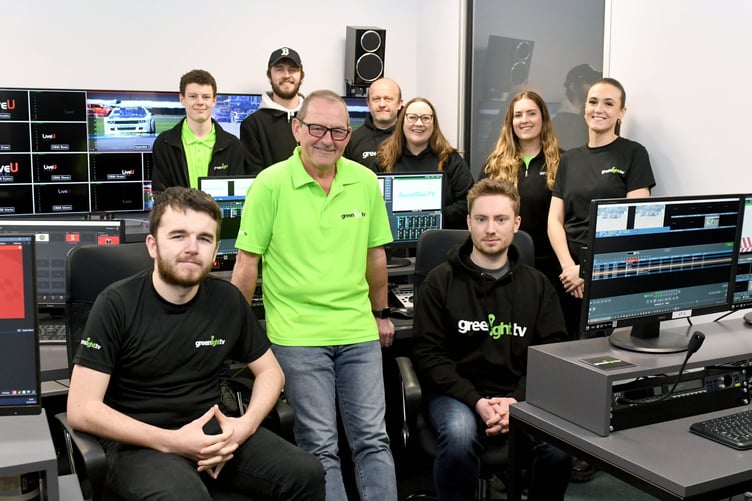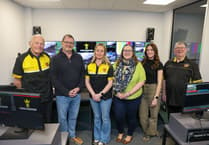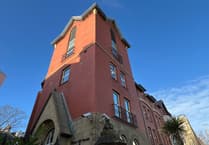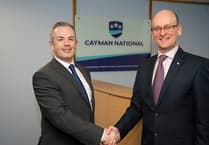Over the last weekend of February the opening round of the Trans AM road racing series took place at Sebring International Raceway in Florida.
The event was covered by an Isle of Man television production company, Greenlight TV, and was live streamed to audiences all around the world.
The really interesting part? It was all done remotely through Greenlight’s production facility, in Tromode.
‘It’s the wonders of modern technology – 27 years ago you’d never have dreamed it was possible,’ says Greenlight director Dave Beynon.
Dave co-founded Greenlight in 1995 with Rob Hurdman and Richard Nicholls.
In those days it was simply not possible to produce live coverage of an event without sending a whole team of people there.
It also involved an eye-wateringly expensive amount of equipment: their first edit suite cost them £350,000. Now, Dave reckons, they could do it for just £15,000.
The first event Greenlight covered was the Macao Grand Prix, followed by the 1995 TT. The company also picked up another, rather glamorous, gig, filming the Ferrari Formula One team.
‘It was great – I mean it’s not like a real job is it? If you’re interested in engines and wheels like me, it’s a great job,’ says Dave.
In those days the format was digi Betacam with all the filming done onto tape, Dave recalls, and he goes on: ‘Remote production was first talked about probably 10 years ago, and this idea of bringing camera signals into the central location rather than being actually at the circuit.
‘Back then, the only way to do it was by sending individual satellite signals back from the track which was totally ineffective, cost-wise, it made no sense.’
The next development was putting fibre lines into football stadia, with enough bandwidth to be able to send all the signals back.
Then came a big breakthrough when a couple of different companies produced transmitters that worked over 4G phone signals.
Dave explains: ‘Effectively what they did was to combine up to eight SIMs. That bandwidth is split across all eight, and it’s bonded, so that gives you enough bandwidth to get the signal back [to the production facility].
‘We did a test just before the pandemic with a TransAm series event. We had the production in our office in Tampa and the cameras were 300 miles away at the circuit and it worked very well. And then the pandemic hit and everything stopped. And we very soon realised, when Trans Am started again, that we wouldn’t be able to travel to the States.’
The big question then was: if you could do it remotely from 300 miles away, could you also do it remotely from 3,000 miles away, on the Isle of Man?
The potential problem was latency, or the amount of time it takes a data package to travel from its origination and reach its destination. Dave says: ‘We took the leap and did a test with a transmitter in Florida and us back here and the latency was fine. It was two seconds which was no different to when it was 300 miles down the road.
‘So in 2020 we took the plunge and built the live production facility here in Tromode, and since then we’ve done everything remotely.’
The way it’s done is that they have cameras around the circuit which send back pictures which arrive at the production suite in Tromode in real time with just a two-second latency. There are cameras filming at different points around the circuit, cameras onboard with competitors, and drone footage.
In the production suite they cut the signals together from one camera to another, mixing them together to create what is the live feed.
Greenlight uses specialist freelance commentators for each different motorsport discipline. They tend to be based at the circuit so that they can describe the atmosphere and speak to the drivers, to get the sort of background that brings a commentary to life. The live feed reaches them half a second after it leaves the production suite, they commentate the programme and that audio comes back to Tromode, where the video is delayed slightly, to make sure that the audio syncs in with the video, and that’s the feed that goes out to the world.
Essentially all this is happening in real time as the race unfolds, as far as the camera crew and commentator at the circuit, the production team in Tromode working on it, and the audience are concerned.
‘It’s time travel,’ says Dave, ‘it’s really strange. We sit here, doing an event in California which is eight hours behind, so we’re in this room looking at pictures of a beautiful sunny day in California and then you finish and you walk outside and it’s two o’clock in the morning and it’s chucking it down with rain and it’s quite bizarre.
‘It can be a bit mind-scrambling at times.’
Greenlight developed its remote expertise around a shorter circuit into taking on the live coverage of the TT. Greenlight also produces the finished programmes which ITV4 puts out during the TT.
Dave says: ‘It enabled the organisers to see what was achievable at a realistic cost and, through the pandemic and the Economic Recovery Group, they managed to get the funding together to try the live coverage last year.
‘But the TT course is a huge undertaking: the size of the course and the geography makes it a big challenge.
‘We had to expand the facilities here for the TT.
‘For last year’s race, in the build up to it, we were still very much in the Covid period and supply chains were difficult so trying to get all the new equipment for it in was a long six months in advance of it.
‘But it was fantastic to be involved with it, especially as a real fan, as we all are here.’
Of all the motorsport events Dave has covered around the world he says that the TT has always been his favourite.
He says: ‘For me, it’s the ultimate motorsport race in the world, by far.’
And when you ask him if he has any particular heroes, he says: ‘They’re all heroes aren’t they? Anybody who gets on a bike, whether they finish first or 65th going round here – they’re heroes.’





Comments
This article has no comments yet. Be the first to leave a comment.